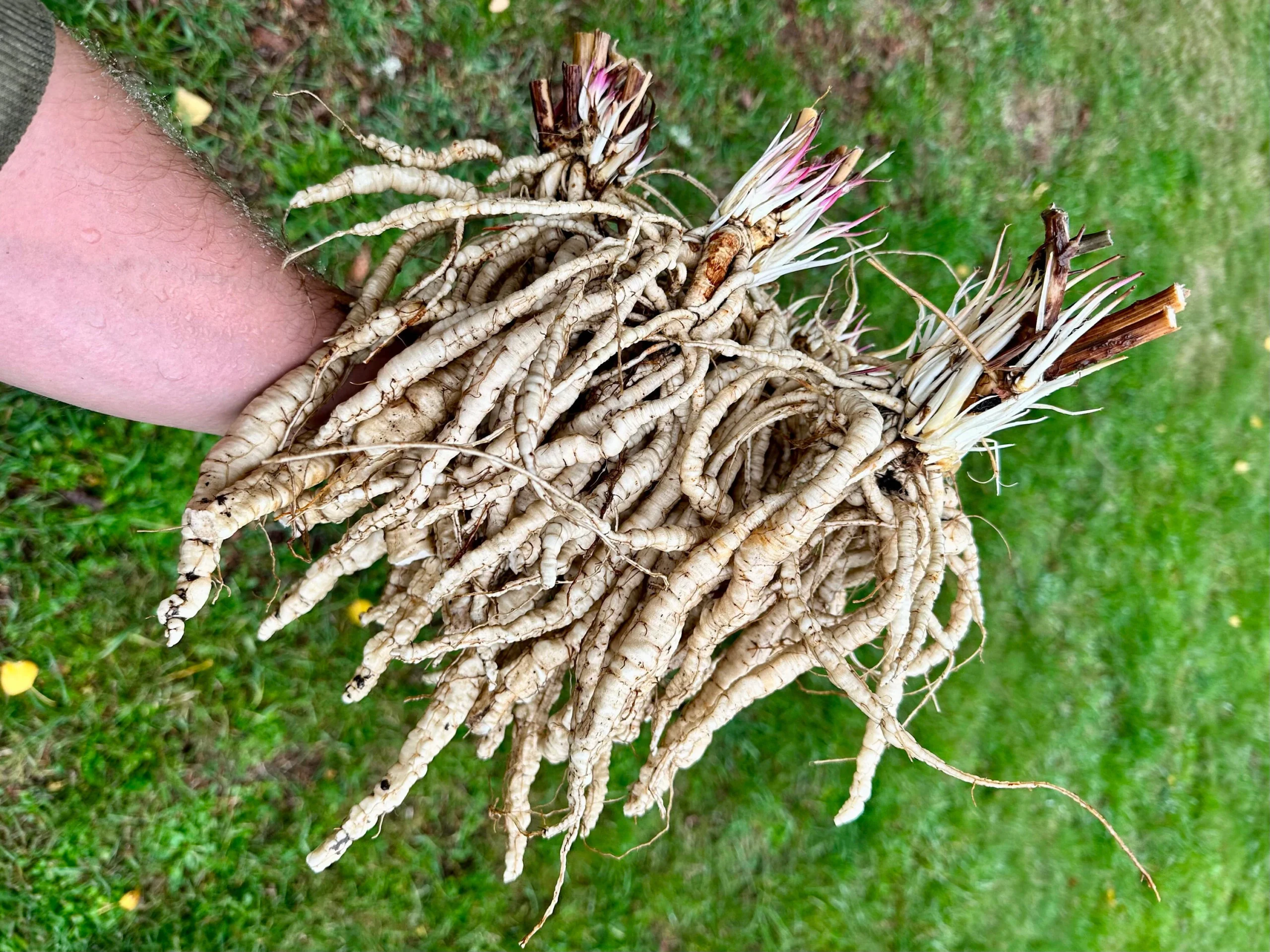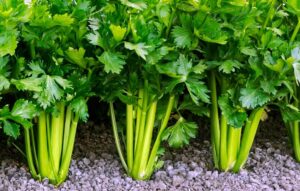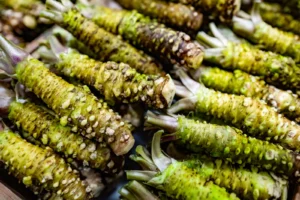How to Grow Skirret: A Comprehensive Guide
Rediscovering an heirloom root vegetable for your kitchen garden
Have you ever heard of skirret? This ancient root vegetable (Sium sisarum) was once a staple in medieval European kitchens before potatoes arrived from the New World. With its sweet, aromatic flavor often described as a cross between parsnip and carrot with hints of coconut or vanilla, skirret is making a comeback among American gardeners seeking unique culinary experiences. In this comprehensive guide, you’ll learn everything about growing this delicious perennial vegetable in your garden, containers, or even indoors.
What is Skirret?
Skirret is a perennial plant in the Apiaceae family (along with carrots, parsley, and celery) that produces clusters of sweet, white tuberous roots. Growing 3-4 feet tall with delicate umbels of white flowers similar to Queen Anne’s lace, skirret makes both a beautiful ornamental plant and a valuable food crop. Unlike many root vegetables, skirret is perennial, meaning you can harvest from the same plants for years.
According to the USDA Agricultural Research Service, skirret (Sium sisarum) was historically valued for its medicinal properties as well as its culinary uses. The plant is rich in inulin, a type of prebiotic fiber beneficial for gut health (USDA ARS Plant Database).
Why Grow Skirret in Your Garden?
- Perennial harvest: Once established, skirret provides edible roots year after year
- Cold hardy: Survives harsh winters in zones 5-9
- Low maintenance: Relatively pest and disease resistant
- Unique flavor: Brings distinctive taste to your kitchen
- Historical connection: Experience a vegetable prized since ancient Roman times

Growing Conditions for Skirret
Before planting skirret, it’s important to understand its preferred growing conditions:
| Factor | Optimal Conditions |
|---|---|
| USDA Hardiness Zones | 5-9 |
| Sun Requirements | Full sun to partial shade |
| Soil pH | 6.0-7.5 |
| Soil Type | Rich, deep, well-draining loam |
| Water Needs | Consistent moisture (not waterlogged) |
| Spacing | 12-18 inches between plants |
| Time to Harvest | 120-150 days from planting for first year roots |
| Winter Care | Mulch in colder zones |
How to Grow Skirret from Seed
Skirret can be grown from seeds, although germination can be somewhat challenging. Here’s how to improve your success rate:
Seed Starting Indoors
- Stratify seeds: To break dormancy, place seeds in a damp paper towel in a plastic bag in your refrigerator for 2-4 weeks before planting.
- Planting time: Start seeds indoors 8-10 weeks before your last spring frost date.
- Sowing technique:
- Use deep seed-starting containers (at least 4 inches deep)
- Fill with seed-starting mix
- Plant seeds ¼ inch deep
- Keep soil consistently moist but not waterlogged
- Provide bottom heat (70-75°F) to improve germination rates
- Germination: Expect germination in 2-4 weeks, though it can be irregular. Be patient!
- Seedling care: Once seedlings have their first true leaves, begin fertilizing weekly with half-strength liquid organic fertilizer.
- Hardening off: About a week before transplanting outdoors, gradually expose seedlings to outdoor conditions, starting with a few hours in dappled shade and working up to full conditions.
Direct Sowing Outdoors
You can direct sow skirret seeds in early spring as soon as the soil can be worked:
- Prepare a seedbed with loose, well-amended soil
- Sow seeds ¼ inch deep in rows 18 inches apart
- Keep the soil consistently moist until germination
- Thin seedlings to 12-18 inches apart when they reach 2-3 inches tall
Pro tip: Mark your planting area well, as skirret seeds are slow to germinate, and you might forget where you planted them!
Growing Skirret in Garden Beds
Skirret thrives in garden beds where it has room to develop its root system:
Site Preparation
- Choose a location with full sun to partial shade. In hotter regions (southern US), afternoon shade is beneficial.
- Prepare soil deeply (at least 12 inches) by loosening and amending with compost. Skirret appreciates rich soil but will grow in average garden soil.
- Ensure good drainage, as skirret doesn’t tolerate waterlogged conditions.
Planting and Care
- Transplanting: Set seedlings outdoors after all danger of frost has passed. Plant at the same depth they were growing in their containers.
- Spacing: Allow 12-18 inches between plants and 18-24 inches between rows.
- Watering: Keep soil consistently moist, especially during the first growing season. Once established, skirret is somewhat drought-tolerant but produces better roots with consistent moisture.
- Mulching: Apply a 2-3 inch layer of organic mulch (straw, shredded leaves, or compost) to conserve moisture and suppress weeds.
- Fertilizing: Side-dress with compost or balanced organic fertilizer in early summer.
Seasonal Care
- First year: Focus on establishing strong plants – you may want to forgo harvesting until the second year.
- Fall care: After the first frost, cut back the foliage to about 2 inches above soil level. In zones 5-6, apply an additional layer of mulch for winter protection.
- Spring care: Remove excess mulch as new growth emerges, and divide any plants that have become overcrowded (every 3-4 years).
Growing Skirret in Containers
Don’t have garden space? Skirret can be grown successfully in containers:
Container Selection
- Choose a deep container (minimum 12-15 inches deep) with adequate drainage holes.
- Larger containers (5-7 gallons) work best, allowing roots to develop properly.
Potting Mix
Create a well-draining but moisture-retentive mix:
- 60% high-quality potting soil
- 20% compost
- 20% perlite or coarse sand for drainage
Container Growing Tips
- Planting: Sow seeds directly or transplant seedlings as you would in a garden bed.
- Watering: Container-grown skirret requires more frequent watering than garden-grown plants. Never allow the soil to completely dry out.
- Fertilizing: Apply liquid organic fertilizer every 2-3 weeks during the growing season.
- Winter care: In zones 5-6, move containers to a protected area (unheated garage or basement) during winter. In zones 7-9, containers can remain outdoors with additional mulch protection.
- Root development: Accept that container-grown roots may be smaller and less numerous than garden-grown plants.

Growing Skirret Indoors
While challenging, it is possible to grow skirret indoors as a novelty:
Indoor Requirements
- Light: Place in your brightest window, ideally south-facing. Supplement with grow lights for 12-14 hours daily if natural light is insufficient.
- Container: Use a deep container (at least 15 inches) with excellent drainage.
- Temperature: Skirret prefers cool temperatures (60-70°F) and will struggle in overly warm rooms.
- Humidity: Increase humidity around plants by placing the container on a tray filled with pebbles and water.
Indoor Growing Challenges
Be aware that indoor-grown skirret:
- Will likely produce fewer and smaller roots
- May not reach its full height
- Requires more attentive care
- Is grown more as an educational project than for significant harvest
Propagation Methods
Beyond seeds, you can propagate skirret through:
Division
- In early spring, dig up established plants (at least 2 years old).
- Carefully separate the crown into sections, ensuring each division has both roots and buds.
- Replant divisions immediately at the same depth they were growing previously.
- Water thoroughly after planting.
This is the fastest way to increase your skirret patch and ensures plants identical to the parent.
Root Cuttings
- When harvesting roots in fall or spring, select several straight, healthy roots (about pencil thickness).
- Cut into 2-3 inch sections.
- Plant horizontally about 1 inch deep in prepared soil or pots.
- Keep soil consistently moist until new growth appears.
Common Pests and Problems
Skirret is relatively trouble-free, but watch for:
- Carrot fly: Protect young plants with row covers or companion plant with onions and garlic
- Aphids: Monitor and spray with strong water stream or insecticidal soap if needed
- Root rot: Avoid in well-draining soil; don’t overwater
- Poor root development: Usually caused by soil that’s too heavy or compacted
Harvesting Skirret
Patience is key with skirret—the flavor improves after frost:
When to Harvest
- First-year plants: Wait until late fall after frost, or even better, harvest the following spring before new growth begins
- Established plants: Harvest selectively, leaving some roots to regrow
Harvesting Technique
- Using a garden fork, carefully loosen the soil around the plant.
- Lift the entire plant or gently extract some of the roots, leaving the crown and some roots in place for future production.
- Wash harvested roots thoroughly.
- For perennial production, replant the crown and some smaller roots.
According to the USDA Natural Resources Conservation Service, protecting soil during harvest helps maintain soil health, especially for perennial root crops like skirret (NRCS Soil Health Portal).
Storing and Using Skirret
After harvest, you have several options for storage:
- Short-term: Store unwashed roots in a plastic bag in the refrigerator for up to 2 weeks
- Root cellar: Store in damp sand or sawdust at 32-40°F for 3-4 months
- In-ground: In milder climates (zones 7-9), leave roots in the ground and harvest as needed
Culinary Uses for Skirret
Now for the rewarding part—enjoying your harvest! Skirret’s sweet, aromatic flavor works well in many dishes:
Preparation
- Scrub roots thoroughly; peeling is optional as the skin is thin.
- The central woody core in larger, older roots may need to be removed after cooking.
Cooking Methods
- Roasted: Toss with olive oil, salt, and herbs; roast at 400°F until tender (about 25-30 minutes)
- Mashed: Boil until tender, then mash with butter and cream like potatoes
- Soups and stews: Add chopped roots to winter soups for sweetness and texture
- Stir-fried: Slice thinly and stir-fry with other vegetables
- Historical recipes: Research medieval recipes featuring skirret for an authentic experience

Growing Skirret for the US Market
With increasing interest in unique and historical vegetables, skirret presents an opportunity for market gardeners and small-scale farmers:
Market Potential
- Farm-to-table restaurants: Chefs seeking unique ingredients for seasonal menus
- Farmers markets: Appeal to customers looking for conversation-piece vegetables
- CSA additions: Diversify vegetable shares with unusual offerings
- Value-added products: Create skirret chips, pickles, or specialty items
Marketing Tips
- Provide recipe cards and cooking instructions
- Share the fascinating history of this ancient vegetable
- Emphasize its perennial nature and sustainability
- Focus on its unique flavor profile that’s unavailable in grocery stores
Conclusion
Growing skirret connects you to centuries of gardening tradition while providing a unique addition to your kitchen. Though it requires some patience and attention to specific growing conditions, the reward is a perennial vegetable that returns year after year with minimal effort.
Whether you’re an experienced gardener looking to expand your repertoire, a culinary enthusiast seeking new flavors, or simply curious about historical vegetables, skirret deserves a place in your garden. Start with a small patch, experiment with different growing methods, and discover why this sweet root vegetable was once a favorite across Europe.
By following the guidance in this article, you’ll be well on your way to harvesting your own skirret crop and exploring its delicious possibilities in your kitchen.






